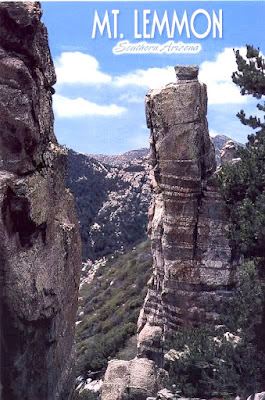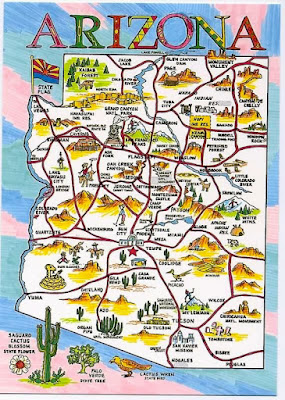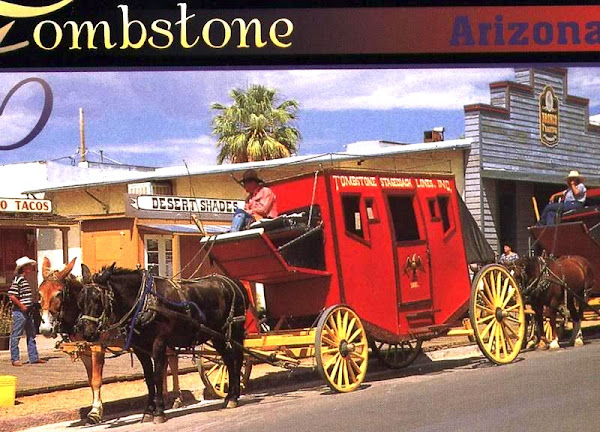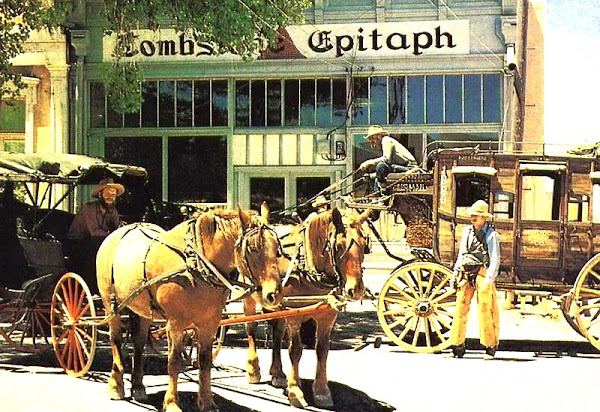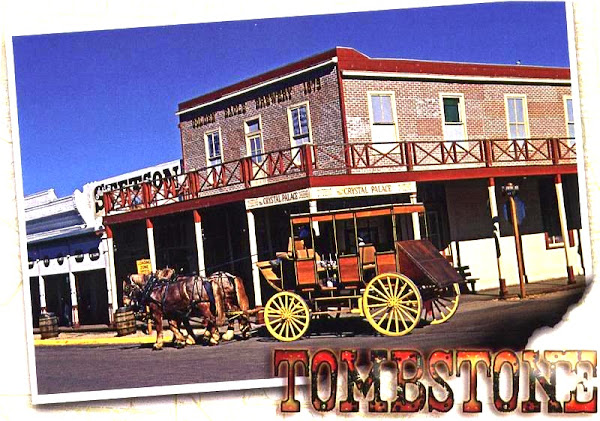Showing posts with label Arizona. Show all posts
Showing posts with label Arizona. Show all posts
Monday, September 30, 2024
Wednesday, August 07, 2024
Thursday, July 25, 2024
Friday, May 31, 2024
Desert Dance
• Desert Dance by Charlotte Armajo and Teri Sloat on Amazon
This is early October (when I first blogged and reviewed this on Preservation Project), and we recently experienced another full Harvest Moon like the one in Desert Dance. In colorfully subtle tertiary hues, Teri Sloat illustrates lizards, wild hares, rattlesnakes, sage hens, wolves, and roadrunners dancing under a bright moon as it illuminates the Southwestern USA desert. This mostly is a picture book of seven 2-page spreads, a title page and a closing page—the enchanting art totally makes the book sing! Not that Charlotte Armajo's simple text that includes a lot of repeated words almost any preschooler or early-grader would understand isn't well-done and appropriate, it just doesn't contain a whole lot of substance or imagination, so 4 stars total.
• my amazon review: desert dancing
This is early October (when I first blogged and reviewed this on Preservation Project), and we recently experienced another full Harvest Moon like the one in Desert Dance. In colorfully subtle tertiary hues, Teri Sloat illustrates lizards, wild hares, rattlesnakes, sage hens, wolves, and roadrunners dancing under a bright moon as it illuminates the Southwestern USA desert. This mostly is a picture book of seven 2-page spreads, a title page and a closing page—the enchanting art totally makes the book sing! Not that Charlotte Armajo's simple text that includes a lot of repeated words almost any preschooler or early-grader would understand isn't well-done and appropriate, it just doesn't contain a whole lot of substance or imagination, so 4 stars total.
• my amazon review: desert dancing
tags, topics
amazon review,
Arizona
Thursday, January 04, 2024
Biosphere2
• From my mostly Arizona chronicles city! life! style! I'm reblogging some good ones here. Photos by Carla, unless otherwise stated.
 Wednesday's special feature was biosphere2 and it was truly a trip! "Biosphere1" is the earth we live on, but you already guessed that. You can visit the website for more information, but how ever anyone could have or would have imagined the original experiment was remotely scientific had something else coming to them.
Wednesday's special feature was biosphere2 and it was truly a trip! "Biosphere1" is the earth we live on, but you already guessed that. You can visit the website for more information, but how ever anyone could have or would have imagined the original experiment was remotely scientific had something else coming to them. 
Rumor has it the eight people who lived and worked at biosphere2 during the original experiment in the early 1990s became physically and mentally very unwell, lost tons of weight and threatened to kill each other.
Well, considering that no natural sunlight entered the building and anyone imagining they could reproduce five environments (ocean with coral reef, mangrove wetlands, tropical rainforest, savannah grassland and fog desert) even in ultra-mini habitable form or especially in an ultra-mini configuration hardly could have been more unreal.

This was the ocean? Looked more like a bay or backyard pool with 1/4" ripples, but then again, I'm used to routine double overheads.

During the course of the 11/2 hour-long uphill, downhill, up the stairs and down the stairs tour the guide defensively explained of course this was not a failed experiment, no way whatsoever! However, I believe that by the early 1990s scientific methods were well established with concepts of controls and common sense solidly in place.
 The people who lived on site (all scientists, carefully selected for their specialties) originally contracted for 5-year terms but due to failing mental and physical health along with many of the originally imported plants and all the animals dying they quit at the 21/2-year point. Rumor has it although they were supposed to find and prepare all their own meals, that wasn't possible with the scant resources available in the limited arrangement and for the final 6 months they got tasty, nutritious meals delivered from a high-end establishment.
The people who lived on site (all scientists, carefully selected for their specialties) originally contracted for 5-year terms but due to failing mental and physical health along with many of the originally imported plants and all the animals dying they quit at the 21/2-year point. Rumor has it although they were supposed to find and prepare all their own meals, that wasn't possible with the scant resources available in the limited arrangement and for the final 6 months they got tasty, nutritious meals delivered from a high-end establishment.
Basic biosphere2 specs include:

Here's a View From The Road— I ♥ Arizona and adore the desert! It amazes me *they* imagined life could prevail in an environment that was close-to hermetically sealed off from the rest of life. Not long before that all of those theys had discerned that a residence needed a certain number of daily exchanges of air in order to be healthy, though previously they'd tried to create situations with fewer air exchanges that still allowed room to breathe and for living things to be.

Who administers this facility? Since June 2007 Biosphere 2 has functioned as a department of the University of Arizona College of Science; they're trying to use it to help quantify some aspects of climate change.
My last pic features the tropical rainforest.
all photos from the biosphere2 website
Rumor has it the eight people who lived and worked at biosphere2 during the original experiment in the early 1990s became physically and mentally very unwell, lost tons of weight and threatened to kill each other.
Well, considering that no natural sunlight entered the building and anyone imagining they could reproduce five environments (ocean with coral reef, mangrove wetlands, tropical rainforest, savannah grassland and fog desert) even in ultra-mini habitable form or especially in an ultra-mini configuration hardly could have been more unreal.
This was the ocean? Looked more like a bay or backyard pool with 1/4" ripples, but then again, I'm used to routine double overheads.
During the course of the 11/2 hour-long uphill, downhill, up the stairs and down the stairs tour the guide defensively explained of course this was not a failed experiment, no way whatsoever! However, I believe that by the early 1990s scientific methods were well established with concepts of controls and common sense solidly in place.
Basic biosphere2 specs include:
- 3.14 acre Biosphere facility
- 7,200,000 cubic feet of sealed glass, 6,500 windows
- 91 feet at highest point
- sealed from the earth below by a 500-ton welded stainless steel liner
- 40-acre campus
- 300,000 sq. ft. of administrative offices, classrooms, labs, conference center, housing
- 3620' elevation
Here's a View From The Road— I ♥ Arizona and adore the desert! It amazes me *they* imagined life could prevail in an environment that was close-to hermetically sealed off from the rest of life. Not long before that all of those theys had discerned that a residence needed a certain number of daily exchanges of air in order to be healthy, though previously they'd tried to create situations with fewer air exchanges that still allowed room to breathe and for living things to be.
Who administers this facility? Since June 2007 Biosphere 2 has functioned as a department of the University of Arizona College of Science; they're trying to use it to help quantify some aspects of climate change.
My last pic features the tropical rainforest.
all photos from the biosphere2 website
tags, topics
Arizona
Mount Lemmon
• From my mostly Arizona chronicles city! life! style! I'm reblogging some good ones here. Photos by Carla, unless otherwise stated.
Saturday afternoon we drove the Catalina Highway - officially "General Hitchcock Highway" – north of Tucson to Mount Lemmon in the Santa Catalina Mountains—a little over three years after the Summer 2003 fires, today was the first snow in two years and the first day vehicles could drive up the canyon without chains or snows. Because it provides delightful respite from blazing heat during the hot summer months, Mount Lemmon, named after botanist Sara Lemmon, who climbed to the top with John, her spouse, in 1881, is extremely popular with Tucsonians. Out-of-towners enjoy it, too, evidenced by a handful of license plates from surrounding Southwestern states as well as many from the Mexican state of Sonora.
At the base of the mountain, Smokey the Bear cautioned, "Moderate Fire Danger." BTW, a while ago I blogged a little about Sabino Canyon, at the foot of Mount Lemmon. Other signs read, "Ice May be Present" and "Watch for Snowplow." We also saw a Bears Crossing graphic sign.
We started seeing snow at about 4,000 feet and thicker snow around 4,500 feet. Mount Lemmon itself is 9,000 feet high! Again I bought postcards, but unhappily they didn't have the snow cards I'd hoped to find; nonetheless, I've included a couple of postcard scans.
The Mount Lemmon landscape goes quickly from a Sonoran lower Desert ecosystem to mid-desert and then to a habitat resembling southern Canada. The transition from desert saguaros, palo verdes, oaks, catclaw, manzanita and mesquite to ponderosa pine, Arizona pine, Apache pine, Chihuahua pine and snow seems abrupt! Amid the hushed wonder and quiet beauty of still-fresh powder, I thought of Elinor Wylie's poem,
Here's a list of the designated campgrounds, trails and vistas we passed; in real life, many of these are all three of the above and more:
Campgrounds: Bear Wallow; General Hitchcock; Gordon Hirabayashi; Loma Linda; Molno Basin and Campground; Peppersauce; Rose Canyon Lake and Campground; Spencer Canyon; Whitetail
Trails: Bigelow; Box Camp; Bug Spring; Butterfly; Green Mountain; Incinerator Ridge; Palisade; Showers Point; Sunset; Sykes Knob Picnic Area
Vistas: Aspen; Babad Do'ag - Tohono O'odham for "Frog Mountain"; San Pedro; Seven Cataracts; Manzanita; Thimble Peak; Thumb Peak; Windy Point
Communities: Ski ValleySoldiers Camp; Summerhaven business and residential district
Saturday afternoon we drove the Catalina Highway - officially "General Hitchcock Highway" – north of Tucson to Mount Lemmon in the Santa Catalina Mountains—a little over three years after the Summer 2003 fires, today was the first snow in two years and the first day vehicles could drive up the canyon without chains or snows. Because it provides delightful respite from blazing heat during the hot summer months, Mount Lemmon, named after botanist Sara Lemmon, who climbed to the top with John, her spouse, in 1881, is extremely popular with Tucsonians. Out-of-towners enjoy it, too, evidenced by a handful of license plates from surrounding Southwestern states as well as many from the Mexican state of Sonora.
At the base of the mountain, Smokey the Bear cautioned, "Moderate Fire Danger." BTW, a while ago I blogged a little about Sabino Canyon, at the foot of Mount Lemmon. Other signs read, "Ice May be Present" and "Watch for Snowplow." We also saw a Bears Crossing graphic sign.
We started seeing snow at about 4,000 feet and thicker snow around 4,500 feet. Mount Lemmon itself is 9,000 feet high! Again I bought postcards, but unhappily they didn't have the snow cards I'd hoped to find; nonetheless, I've included a couple of postcard scans.
The Mount Lemmon landscape goes quickly from a Sonoran lower Desert ecosystem to mid-desert and then to a habitat resembling southern Canada. The transition from desert saguaros, palo verdes, oaks, catclaw, manzanita and mesquite to ponderosa pine, Arizona pine, Apache pine, Chihuahua pine and snow seems abrupt! Amid the hushed wonder and quiet beauty of still-fresh powder, I thought of Elinor Wylie's poem,
Velvet Shoes
Let us walk in the white snow
In a soundless space;
With footsteps quiet snd slow,
At a tranquil pace,
Under veils of white lace.
I shall go shod in silk,
And you in wool,
White as white cow's milk,
More beautiful
Than the breast of a gull.
We shall walk through the still town
In a windless peace;
We shall step upon white down,
Upon silver fleece,
Upon softer than these.
We shall walk in velvet shoes:
Wherever we go
Silence will fall like dews
On white silence below.
We shall walk in the snow.
Here's a list of the designated campgrounds, trails and vistas we passed; in real life, many of these are all three of the above and more:
Campgrounds: Bear Wallow; General Hitchcock; Gordon Hirabayashi; Loma Linda; Molno Basin and Campground; Peppersauce; Rose Canyon Lake and Campground; Spencer Canyon; Whitetail
Trails: Bigelow; Box Camp; Bug Spring; Butterfly; Green Mountain; Incinerator Ridge; Palisade; Showers Point; Sunset; Sykes Knob Picnic Area
Vistas: Aspen; Babad Do'ag - Tohono O'odham for "Frog Mountain"; San Pedro; Seven Cataracts; Manzanita; Thimble Peak; Thumb Peak; Windy Point
Communities: Ski ValleySoldiers Camp; Summerhaven business and residential district
tags, topics
Arizona
Tombstone
• From my mostly Arizona chronicles city! life! style! I'm reblogging some good ones here. Photos by Carla, unless otherwise stated.
This afternoon we drove to Cochise County and to Tombstone, "The Town too Tough to Die," and reputedly the only remaining true Western frontier town. The town site lists population as a mere 1,504 people with a high desert elevation of 4,540 feet. Here are the postcards I bought:
I'm concluding with a picture of Wyatt—we went to Tombstone to visit Wyatt and his Dad, Johnny, since they may be moving to the UK soon.
This afternoon we drove to Cochise County and to Tombstone, "The Town too Tough to Die," and reputedly the only remaining true Western frontier town. The town site lists population as a mere 1,504 people with a high desert elevation of 4,540 feet. Here are the postcards I bought:
tags, topics
Arizona
Oracle State Park
• From my mostly Arizona chronicles city! life! style! I'm reblogging some good ones here. Photos by Carla, unless otherwise stated.


This afternoon we took a short drive away from the city of Tucson and visited Oracle State Park Center for Environmental Education. Information on the website describes:
"A 4,000 acre environmental education park and approximately 15 miles of hiking trails; Historic Kannally Ranch House Tours; Oracle State Park is located approximately 45 minutes from Tucson, in the northern foothills of the Santa Catalina Mountains near the community of Oracle in southern Pinal County. Ranging from 3,500 to 4,500 feet in elevation, the nearly 4,000-acre park consists of oak grassland, riparian woodland, and mesquite scrub habitats which contain a diversity of wildlife and plant species."

"In 1902 Neil Kannally arrived in Oracle from Illinois. Moving to the area for relief from tuberculosis, he homesteaded the land that would later become the park. Later, other members of the Kannally family joined him."

"The ranch grew substantially over the next several years and eventually 1100 cattle grazed the land. In 1976, Lucille Kannally, the last surviving family member, donated the land to the Defenders of Wildlife who later transferred the property to the State Parks Board."


The adobe Kannally Ranch House, constructed between approximately 1929 and 1932 after "Italian Renaissance and Mediterranean Revival Style architecture with Moorish influences" turned out to be amazingly spacious inside,


although it looked like a mini-cottage from where we parked the vehicle. I especially loved the clean, spare style of Lee Kannally's southwestern paintings displayed in the living room.
This afternoon we took a short drive away from the city of Tucson and visited Oracle State Park Center for Environmental Education. Information on the website describes:
"A 4,000 acre environmental education park and approximately 15 miles of hiking trails; Historic Kannally Ranch House Tours; Oracle State Park is located approximately 45 minutes from Tucson, in the northern foothills of the Santa Catalina Mountains near the community of Oracle in southern Pinal County. Ranging from 3,500 to 4,500 feet in elevation, the nearly 4,000-acre park consists of oak grassland, riparian woodland, and mesquite scrub habitats which contain a diversity of wildlife and plant species."
"In 1902 Neil Kannally arrived in Oracle from Illinois. Moving to the area for relief from tuberculosis, he homesteaded the land that would later become the park. Later, other members of the Kannally family joined him."
"The ranch grew substantially over the next several years and eventually 1100 cattle grazed the land. In 1976, Lucille Kannally, the last surviving family member, donated the land to the Defenders of Wildlife who later transferred the property to the State Parks Board."
The adobe Kannally Ranch House, constructed between approximately 1929 and 1932 after "Italian Renaissance and Mediterranean Revival Style architecture with Moorish influences" turned out to be amazingly spacious inside,
although it looked like a mini-cottage from where we parked the vehicle. I especially loved the clean, spare style of Lee Kannally's southwestern paintings displayed in the living room.
tags, topics
Arizona
Sea Dreams among the Mesquite
• From my mostly Arizona chronicles city! life! style! I'm reblogging some good ones here. Photos by Carla, unless otherwise stated.


Over on an inactive blog I posted a basic and perfunctory Noel 2007 narrative, but about a third of the way into January I have a really good one for today! For starters, during my recent visit to Tucson, the ride toward the international border as we drove out to Rio Rico-Rich River was amazing! Remember, this is the Sonoran desert with its exceptional biodiversity that absolutely for sure does not include coastal, shoreside, seashore, seaside or beach habitat. I love the title I gave this post—back in my cultural anthropology classes, the professor frequently commented on people stereotyping to such a degree they talked about customs, etc."among the whomever whatever whichever" culture in question, but today I truly am writing about things I witnessed amidst desert plants like the (yes, stereotypical, usual) mesquite and similar.
Street names included nautical language like océano, mar, ballena, mariscos, embarcadero, muelle, playa, langosta, huracán, agua linda, agua salada, (plus Finlandia and Dinamarca).


I've blogged and posted elsewhere some pictures from the seafaring town of Harwich, Massachusetts and about Salem, Massachusetts—we'd drive up the shore from Boston to Salem when we lived in Boston and later up the Shore to Marblehead, Ipswich and Gloucester when we lived in Salem, but in those cases you'd expect the vocabulary to align with the land—and seascape, which it sometimes did, though lots of streets and roads and churches and buildings got named after historical people or happenings.
On our exodus out of Rio Rico, we enjoyed cattle crossing—javalina, too, but didn't get any pics of the javvies. Given the considerable size of the bovine population cohort, we were able to get some great cattle pics; you can see four of the best right here!
Over on an inactive blog I posted a basic and perfunctory Noel 2007 narrative, but about a third of the way into January I have a really good one for today! For starters, during my recent visit to Tucson, the ride toward the international border as we drove out to Rio Rico-Rich River was amazing! Remember, this is the Sonoran desert with its exceptional biodiversity that absolutely for sure does not include coastal, shoreside, seashore, seaside or beach habitat. I love the title I gave this post—back in my cultural anthropology classes, the professor frequently commented on people stereotyping to such a degree they talked about customs, etc."among the whomever whatever whichever" culture in question, but today I truly am writing about things I witnessed amidst desert plants like the (yes, stereotypical, usual) mesquite and similar.
Street names included nautical language like océano, mar, ballena, mariscos, embarcadero, muelle, playa, langosta, huracán, agua linda, agua salada, (plus Finlandia and Dinamarca).
I've blogged and posted elsewhere some pictures from the seafaring town of Harwich, Massachusetts and about Salem, Massachusetts—we'd drive up the shore from Boston to Salem when we lived in Boston and later up the Shore to Marblehead, Ipswich and Gloucester when we lived in Salem, but in those cases you'd expect the vocabulary to align with the land—and seascape, which it sometimes did, though lots of streets and roads and churches and buildings got named after historical people or happenings.
On our exodus out of Rio Rico, we enjoyed cattle crossing—javalina, too, but didn't get any pics of the javvies. Given the considerable size of the bovine population cohort, we were able to get some great cattle pics; you can see four of the best right here!
tags, topics
Arizona
Ramsey Canyon Preserve 2
• From my mostly Arizona chronicles city! life! style! I'm reblogging some good ones here. Photos by Carla, unless otherwise stated.
• The Nature Conservancy's Ramsey Canyon Preserve website




• The Nature Conservancy's Ramsey Canyon Preserve website
tags, topics
Arizona
Ramsey Canyon Preserve 1
• From my mostly Arizona chronicles city! life! style! I'm reblogging some good ones here. Photos by Carla, unless otherwise stated.
• The Nature Conservancy's Ramsey Canyon Preserve website




• The Nature Conservancy's Ramsey Canyon Preserve website
tags, topics
Arizona
Ramsey Canyon Preserve
• From my mostly Arizona chronicles city! life! style! I'm reblogging some good ones here. Photos by Carla, unless otherwise stated.

Late this morning we drove south toward growing, increasingly dynamic Sierra Vista to The Nature Conservancy's amazing Ramsey Canyon Preserve.
Some notes from the site:
As contrasted with (here's my Southern Arizona Travelogue) two years ago, this time we got some updated trail guides―adult's and kid's versions. I'd like to quote some from both, but that'll have to wait until I have a time to sift through and select some of the most interesting stuff.

At Boundless Gallery I bought this glorious bird card by Lisa K. Walraven; the self-titled site listed on the back of the card wasn't live when I tried.
Returning to Tucson through Sierra Vista, we stopped for late lunch at a McDonald's characteristically decorated with southwestern desert textiles and metalwork.
Late this morning we drove south toward growing, increasingly dynamic Sierra Vista to The Nature Conservancy's amazing Ramsey Canyon Preserve.
Some notes from the site:
Ramsey Canyon, located within the Upper San Pedro River Basin in southeastern Arizona, is renowned for its outstanding scenic beauty and the diversity of its plant and animal life. This diversity―including such highlights as 15 species of hummingbirds―is the result of a unique interplay of geology, biogeography, topography, and climate.
Southeastern Arizona is an ecological crossroads, where the Sierra Madre of Mexico, the Rocky Mountains, and the Sonoran and Chihuahuan deserts all come together. The abrupt rise of mountains like the Huachucas from the surrounding arid grasslands creates "sky islands" harboring rare species and communities of plants and animals. This combination of factors gives Ramsey Canyon Preserve its tremendous variety of plant and animal life, including such southwestern specialties as the lemon lily, ridge-nosed rattlesnake, lesser long-nosed bat, elegant trogon, and berylline and white-eared hummingbirds.
A spring-fed stream, northeast orientation, and high canyon walls provide Ramsey Canyon with a moist, cool environment unusual in the desert Southwest. Water-loving plants such as sycamores, maples, and columbines line the banks of Ramsey Creek, often growing within a few feet of cacti, yucca, and agaves. Communities ranging from semi-desert grassland to pine-fir forest are found within the vicinity of Ramsey Canyon Preserve.
Ramsey Canyon and the Upper San Pedro River Basin are situated within the Apache Highlands ecoregion, which encompasses central and southeastern Arizona, southwest New Mexico, and the northern Sierra Madre of Mexico. These programs are part of a science-based ecoregional approach to conservation in which the Conservancy works across broad landscapes with many private and public partners, sharing resources and knowledge to expedite the protection of species and habitats throughout the state.
Together, The Nature Conservancy works with partners to achieve much greater success than any one entity working independently. Multiple partners also ensure a broader perspective and more enduring conservation solutions.
As contrasted with (here's my Southern Arizona Travelogue) two years ago, this time we got some updated trail guides―adult's and kid's versions. I'd like to quote some from both, but that'll have to wait until I have a time to sift through and select some of the most interesting stuff.
At Boundless Gallery I bought this glorious bird card by Lisa K. Walraven; the self-titled site listed on the back of the card wasn't live when I tried.
Returning to Tucson through Sierra Vista, we stopped for late lunch at a McDonald's characteristically decorated with southwestern desert textiles and metalwork.
tags, topics
Arizona
Desert Museum Too
• From my mostly Arizona chronicles city! life! style! I'm reblogging some good ones here. Photos by Carla, unless otherwise stated.








tags, topics
Arizona
Subscribe to:
Posts (Atom)








